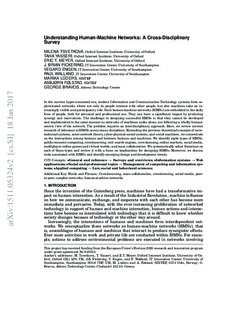Understanding human-machine networks: A cross-disciplinary survey
| dc.contributor.author | Tsvetkova, Milena | |
| dc.contributor.author | Yasseri, Taha | |
| dc.contributor.author | Meyer, Eric T. | |
| dc.contributor.author | Pickering, J. Brian | |
| dc.contributor.author | Engen, Vegard | |
| dc.contributor.author | Walland, Paul | |
| dc.contributor.author | Lüders, Marika | |
| dc.contributor.author | Følstad, Asbjørn | |
| dc.contributor.author | Bravos, George | |
| dc.date.accessioned | 2017-11-09T09:19:31Z | |
| dc.date.available | 2017-11-09T09:19:31Z | |
| dc.date.created | 2017-08-26T18:33:21Z | |
| dc.date.issued | 2017 | |
| dc.identifier.citation | ACM Computing Surveys. 2017, 50 (1), 1-35. | nb_NO |
| dc.identifier.issn | 0360-0300 | |
| dc.identifier.uri | http://hdl.handle.net/11250/2465119 | |
| dc.description.abstract | In the current hyperconnected era, modern Information and Communication Technology (ICT) systems form sophisticated networks where not only do people interact with other people, but also machines take an increasingly visible and participatory role. Such Human-Machine Networks (HMNs) are embedded in the daily lives of people, both for personal and professional use. They can have a significant impact by producing synergy and innovations. The challenge in designing successful HMNs is that they cannot be developed and implemented in the same manner as networks of machines nodes alone, or following a wholly human-centric view of the network. The problem requires an interdisciplinary approach. Here, we review current research of relevance to HMNs across many disciplines. Extending the previous theoretical concepts of socio-technical systems, actor-network theory, cyber-physical-social systems, and social machines, we concentrate on the interactions among humans and between humans and machines. We identify eight types of HMNs: public-resource computing, crowdsourcing, web search engines, crowdsensing, online markets, social media, multiplayer online games and virtual worlds, and mass collaboration. We systematically select literature on each of these types and review it with a focus on implications for designing HMNs. Moreover, we discuss risks associated with HMNs and identify emerging design and development trends. | nb_NO |
| dc.language.iso | eng | nb_NO |
| dc.relation.uri | https://arxiv.org/abs/1511.05324 | |
| dc.rights | Attribution-NonCommercial-NoDerivatives 4.0 Internasjonal | * |
| dc.rights.uri | http://creativecommons.org/licenses/by-nc-nd/4.0/deed.no | * |
| dc.title | Understanding human-machine networks: A cross-disciplinary survey | nb_NO |
| dc.type | Journal article | nb_NO |
| dc.type | Peer reviewed | nb_NO |
| dc.description.version | acceptedVersion | nb_NO |
| dc.source.pagenumber | 1-35 | nb_NO |
| dc.source.volume | 50 | nb_NO |
| dc.source.journal | ACM Computing Surveys | nb_NO |
| dc.source.issue | 1 | nb_NO |
| dc.identifier.doi | 10.1145/3039868 | |
| dc.identifier.cristin | 1488813 | |
| dc.relation.project | EC/H2020/645043 | nb_NO |
| cristin.unitcode | 7401,90,12,0 | |
| cristin.unitname | Nettbaserte systemer og tjenester | |
| cristin.ispublished | true | |
| cristin.fulltext | postprint | |
| cristin.qualitycode | 2 |
Tilhørende fil(er)
Denne innførselen finnes i følgende samling(er)
-
Publikasjoner fra CRIStin - SINTEF AS [5801]
-
SINTEF Digital [2501]

